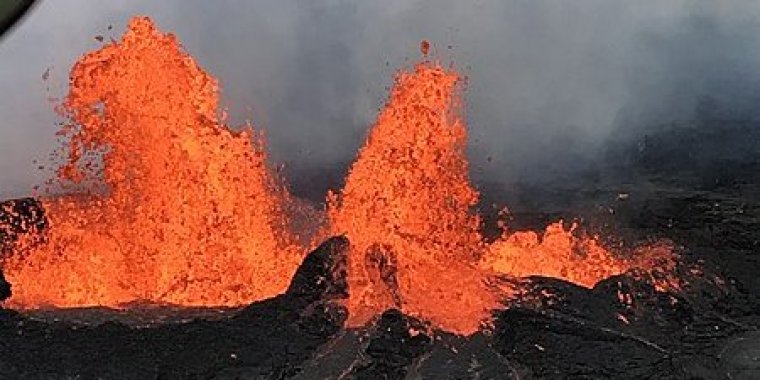| News / Science News |
Size matters: if you are a bubble of volcanic gas
Changes in the output or proportions of different gases - such as carbon dioxide and sulphur dioxide – can herald shifts in the activity of a volcano. Volcanologists have considered that these chemical changes reflect the rise and fall of magma in the Earth’s crust but the new research reveals that the composition of volcanic gases depends also on the size of the gas bubbles rising up to the surface.

Kīlauea Volcano - lava fountains at fissure 22. Image credit: USGS
Until the latest spectacular eruption opened up fissures on the flank of the volcano, Kīlauea volcano in Hawaii held a vast lava lake in its summit crater. The behaviour of this lava lake alternated between phases of fiery ‘spattering’ powered by large gas bubbles bursting through the magma, and more gentle gas release, accompanied by slow and steady motion of the lava.
Each individual measurement was used to compute the temperature of the volcanic gas. What immediately struck the scientists was that the gas temperatures ranged from 1150 degrees Celsius – the temperature of the lava – down to around 900 degrees Celsius. “At this temperature, the lava would freeze,” said lead author Dr Clive Oppenheimer, from Cambridge’s Department of Geography. “At first, we couldn’t understand how the gases could emerge much colder than the molten lava sloshing in the lake.”
The clue to this puzzle came from the variation in calculated gas temperatures – they were high when the lava lake was placid, and low when it was bubbling furiously. It could be because of the size of the gas bubbles.
Larger bubbles rise faster through the magma and expand rapidly as the pressure reduces, just like bubbles rising in a glass of fizzy drink; the gas cools down because of the expansion. Larger bubbles form when smaller bubbles bump into each other and merge.
But there was yet another surprising finding from the gas observations from Hawaii. As well as being cooler, the emissions from the large gas bubbles were more oxidised than expected – they had higher proportions of carbon dioxide to carbon monoxide.
The chemical balance of volcanic gases such as carbon dioxide and carbon monoxide (or sulphur dioxide and hydrogen sulphide) is generally thought to be controlled by the chemistry of the surrounding liquid magma but what the new findings showed is that when bubbles get large enough, most of the gas inside follows its own chemical pathway as the gas cools.
The ratio of carbon dioxide to carbon monoxide when the lava lake was in its most energetic state was six times higher than during the most stable phase. The scientists suggest this effect should be taken into account when gas measurements are being used to forecast major changes in volcanic activity.
And there is another implication of this discovery – not for eruptions today but for the evolution of the Earth’s atmosphere billions of years ago. Volcanic emissions in Earth’s deep past may have made the atmosphere more oxidising than we thought.
A more oxygen-rich atmosphere would have facilitated the emergence and viability of life on land, by generating an ozone layer, which shields against harmful ultraviolet rays from the sun.
YOU MAY ALSO LIKE



